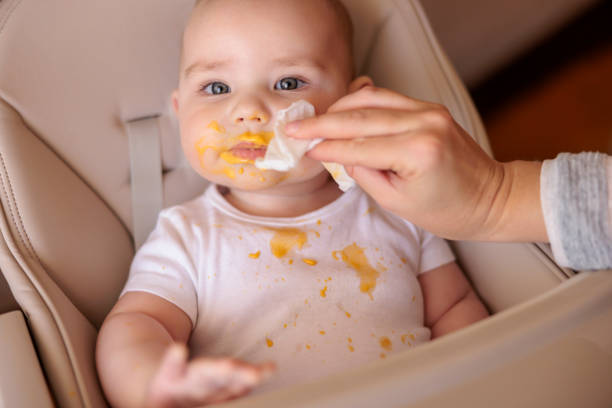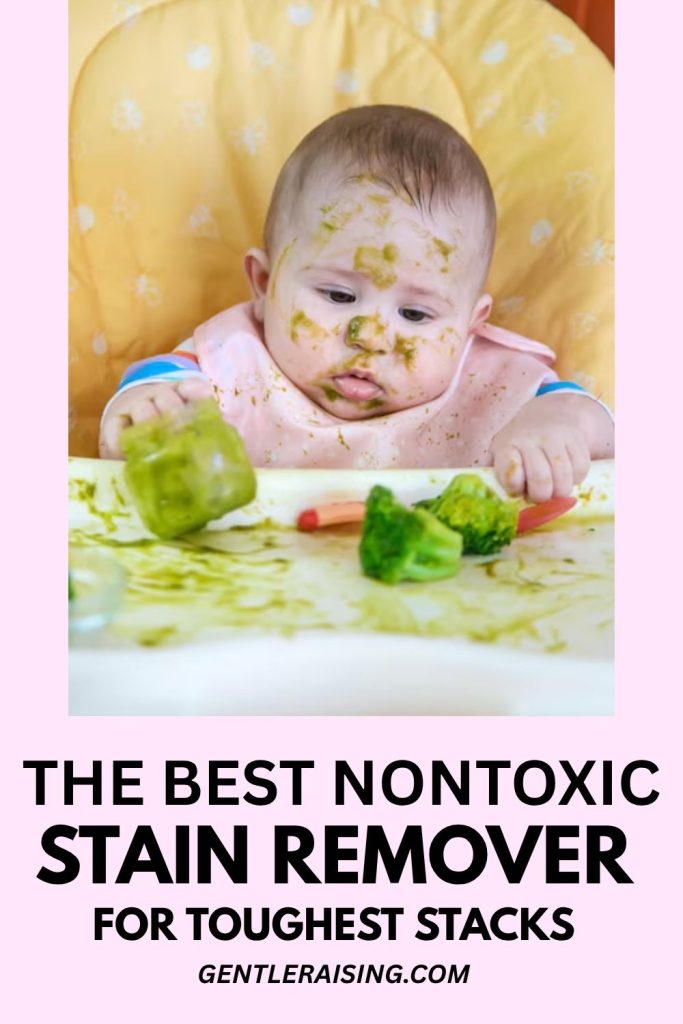Your little one is dressed in the cutest onesie you own. You’ve got the camera ready, the lighting’s perfect, and then it happens.
One determined spoonful of mashed sweet potato takes a nosedive straight down their front. It doesn’t just land on the bib (of course not), it ricochets to the sleeve, the pants, and somehow your shirt too.
Every parent has been there. The war on baby food stains is real, and if you’ve ever stared at a smear of carrot puree on brand-new white cotton and thought, “That’s never coming out,” you’re not alone.
But here’s the good news: most stains can be saved if you know the right tricks. The real secret? A mix of quick thinking, gentle techniques, and a little science. Oh, and not beating yourself up when the mess wins.
Why Baby Food Stains Are So Stubborn
It’s not just your imagination; some baby foods seem to have it out for your laundry. There’s a scientific reason for this.
- Carrots, pumpkins, sweet potatoes – They’re packed with beta-carotene, a natural pigment that’s great for your baby’s eyes but terrible for your laundry. These pigments bind to fabric fibres like glue.
- Berries & beets – Rich in anthocyanins and betalains, they’re natural dyes. Fun fact: some old-fashioned dyes for cloth came from plants like these.
- Formula, breastmilk spit-up, or yoghurt – These have proteins that “cook” into the fabric if exposed to heat too soon.
- Avocado & oily snacks – Oils seep into fibres, making them tricky to lift without proper treatment.
So it’s not that you’re doing something wrong, you’re just battling natural chemistry.
Rule Number One – Act Fast (But Stay Sane)
You’ll hear stain experts say, “Treat it immediately!” And yes, that’s the gold standard… but we’re parents, not laundry fairies. Sometimes you’re mid-grocery run or the stain happens five minutes before bedtime.
If you can treat it fast:
- Rinse the stained area in cold water to flush out as much as possible before it sets.
- Blot, don’t rub. Rubbing can push the stain deeper into the fibres.
If you can’t treat it right away:
- Pat with a wet wipe to keep it damp.
- Keep a small emergency parenting kit in your diaper bag: travel-sized baby-safe stain spray (Dreft or Puracy), a resealable bag for dirty clothes, and a small cloth. It won’t remove the stain completely on the spot, but it will give you a fighting chance later.
Pre-Treatment – Setting the Stage for a Rescue
Before you toss stained clothes in the wash, you want to give the fabric the best chance of releasing that stubborn mark.
Cold Water is Your Friend
Always start with cold water. Hot water can “cook” proteins (formula, yoghurt, spit-up) into the fabric and make them harder to remove.
Baby-Safe Stain Removers
Some good options parents swear by:
- Dreft Stain Remover Spray – Gentle on baby fabrics.
- Ecover Stain Remover – Plant-based with a built-in brush.
- Puracy Natural Stain Remover – Works well on both food and diaper blowouts.
DIY Solutions
If you don’t have commercial stain remover:
- Baking soda paste – Mix baking soda with water, apply, let sit for 15 minutes, then rinse.
- White vinegar – Especially good for berry stains.
- Lemon juice – Works well on light fabrics (and the sun will boost the effect).
Gently work the solution in with your fingers or a soft toothbrush, but don’t go scrubbing like you’re polishing the kitchen sink. Baby fabrics can fray easily.
Targeted Hacks for Specific Baby Food Stains
Carrot & Sweet Potato (The Infamous Orange Stain)
- Rinse in cold water.
- Pre-treat with enzyme-based detergent.
- Wash as normal, then dry in sunlight. UV light helps break down the orange pigments naturally.
Berry & Beetroot (Purple-Red Trouble)
- Soak in lemon juice for 5–10 minutes.
- Sprinkle a pinch of salt on top to help lift pigment.
- Rinse, then wash with oxygen-based cleaner.
Pro tip: Milk soak method. Submerge the stain in milk for 30 minutes before washing. Sounds strange, but the proteins in milk can bind to berry pigments and lift them out.
Formula & Breastmilk Spit-Up
- Rinse in cold water.
- Rub a drop of baby-safe dish soap (like Dapple) into the stain.
- Let it sit for 10 minutes before washing.
Avocado & Oily Snacks
- Sprinkle cornstarch or talc over the stain and let it sit for 15 minutes to absorb oil.
- Brush off powder.
- Wash in warm (not hot) water with regular detergent.
The Sun – Nature’s Secret Weapon
Honestly, sunlight is one of the cheapest and safest stain-removal tools you’ll ever use. Those UV rays work like a natural bleach without the harsh chemicals.
- Lay clothes flat or hang them outside after washing.
- Check every hour or so; leaving them in strong sunlight for too long can weaken fibres.
- Parents often say they’ve seen a stain fade almost magically after just an afternoon in the sun.
I once had a friend send me a “before and after” picture after a blueberry disaster. Morning: bright purple splotch. Afternoon: spotless all thanks to a few hours on the clothesline.
The “Set It and Forget It” Myth
We’ve all been tempted to just toss stained clothes into a bucket and forget about them for a few days. The problem is that it can create new problems odours, mildew, or even the spreading.
- Ideal soak time? 30 minutes to a few hours, depending on the stain.
- If you soak overnight, change the water once to keep it fresh.
- Always rinse thoroughly before tossing in the machine.
When the Stain Won’t Budge – Second Chance Tricks
Some stains are stubborn, but not invincible.
- Hydrogen Peroxide (3%) – Great for whites. Pour directly on the stain, wait a minute, rinse. (Not for colored fabrics, it can lighten them.)
- Oxygen-based cleaners – Brands like OxiClean Baby are colour-safe and effective.
- The “check before drying” rule: If the stain’s still visible after washing, don’t put it in the dryer. Heat will set it permanently. Repeat the treatment instead.
Avoiding Future Stains Without Killing the Fun
Let’s be honest, messy eating is good for babies. It’s part of learning textures, tastes, and motor skills. But you can still set yourself up for fewer laundry battles.
- Invest in full-coverage bibs like Bumkins or Baby Bjorn; they cover shoulders and lap.
- Have a set of “food clothes” in darker colours or patterns that hide stains better.
- Use washable splash mats under the high chair.
- Cover yourself, too. I’ve ruined more T-shirts than I care to admit.
What NOT to Do
- Avoid bleach on baby clothes, even if the label says it’s safe. Babies’ skin is sensitive.
- Don’t pour boiling water on protein stains; it cooks them in.
- Skip highly scented detergents they can irritate skin.
Keeping Your Sanity While Raising a Messy Eater
Here’s the truth: no matter how many tricks you have, some stains will win. And that’s okay.
Have a rotation:
- Play clothes – for messy meals, park days, and art time.
- Photo clothes – for when you want that adorable, stain-free look.
And remember, one day, those stained onesies will be tiny keepsakes in a box, and you’ll laugh about the “Great Blueberry Incident of 2025.”
Final Thoughts – Clothes Can Be Saved (and So Can Your Mood)
Baby food stains aren’t the enemy; they’re just part of the story you’re living right now. With quick action, the right products, and a little patience, most stains can be rescued. And even if they can’t? That messy moment probably came with a giggle, a proud “I fed myself!” look, or a memory worth keeping.
So, grab your stain spray, hang your laundry in the sun, and embrace the beautiful, sticky chaos of raising a little human.

